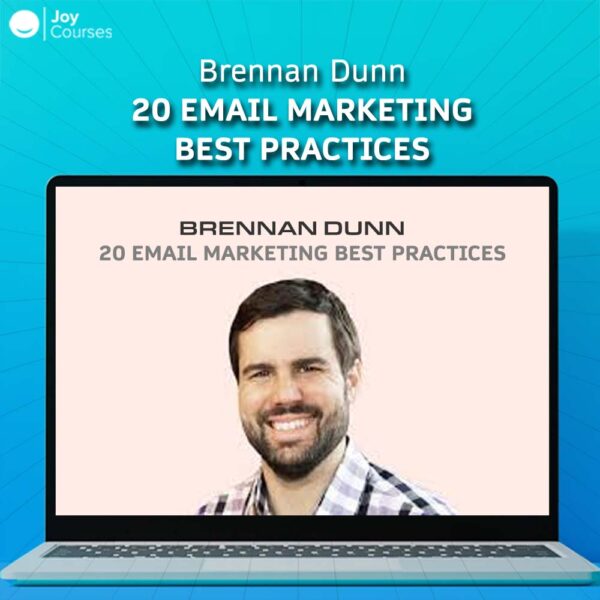Description
20 Email Marketing Best Practices – Brennan Dunn
![]()
20 Email Marketing Best Practices by Brennan Dunn
In the world of digital marketing, email marketing remains one of the most powerful tools for driving engagement, building relationships, and increasing sales. Brennan Dunn, an expert in email marketing, has shared some key best practices that help businesses maximize the impact of their email campaigns. Whether you’re a seasoned marketer or just starting out, these 20 email marketing best practices will help you create more effective, engaging, and conversion-driven emails.
1. Build a High-Quality Email List
Focus on quality over quantity. Grow your list organically by attracting people who are genuinely interested in your brand. Avoid buying lists, as this can hurt your deliverability and reputation.
2. Segment Your Audience
Not all subscribers are the same. Segment your email list based on behavior, interests, or demographic data. This allows you to send more relevant content to each group, increasing engagement.
3. Personalize Your Emails
Use your subscribers’ names and personalize content based on their preferences and behavior. Personalized emails often result in higher open rates, click-through rates, and conversions.
4. Craft Compelling Subject Lines
The subject line is your email’s first impression. Keep it short, relevant, and intriguing to encourage opens. A/B test different subject lines to discover what resonates with your audience.
5. Optimize for Mobile
Ensure your emails are mobile-responsive. Many users open emails on their smartphones, so your content should be easy to read and interact with on smaller screens.
6. Use a Clear Call to Action (CTA)
Every email should have a clear purpose and a single, focused CTA. Whether it’s clicking a link, signing up for an event, or purchasing a product, make sure your CTA stands out and is easy to understand.
7. Keep Your Emails Short and Sweet
Respect your readers’ time by keeping emails concise. Get to the point quickly and avoid overwhelming your subscribers with too much information.
8. Automate Your Emails
Use automation to send timely, relevant messages. Drip campaigns, welcome sequences, and cart abandonment emails can help nurture leads and guide subscribers through the buyer’s journey.
9. A/B Test Regularly
Continuously optimize your email performance by A/B testing different elements, such as subject lines, email copy, CTAs, and visuals. Use the results to refine your approach.
10. Maintain a Consistent Schedule
Regularly communicate with your audience to keep them engaged, but avoid over-emailing. Find a balance that works for your audience and stick to a consistent sending schedule.
11. Write in a Conversational Tone
People connect with people, not brands. Write your emails as if you’re speaking directly to a friend. Use a conversational, friendly tone to build rapport with your subscribers.
12. Add Value with Every Email
Provide useful, relevant content in every email. Whether it’s educational, entertaining, or exclusive offers, make sure your emails deliver value that resonates with your audience.
13. Leverage Social Proof
Incorporate testimonials, reviews, and case studies in your emails. Social proof helps build trust and encourages readers to take action based on others’ experiences.
14. Ensure Compliance with Privacy Laws
Follow email regulations like GDPR and CAN-SPAM by obtaining explicit consent from subscribers, offering an easy way to unsubscribe, and clearly stating your business identity in every email.
15. Use Engaging Visuals
Incorporate images, GIFs, and videos to make your emails visually appealing. However, balance visuals with text to ensure your message still gets across even if images don’t load.
16. Monitor Your Email Metrics
Track important metrics like open rates, click-through rates, bounce rates, and conversions. Regularly analyze these metrics to understand what’s working and where you can improve.
17. Optimize for Deliverability
To improve deliverability, focus on sender reputation, use double opt-ins, and avoid spammy words. This ensures your emails land in the inbox, not the spam folder.
18. Send Re-Engagement Campaigns
Keep your list clean and engaged by sending re-engagement campaigns to inactive subscribers. If they don’t respond, consider removing them to improve list health and engagement rates.
19. Utilize Behavioral Triggers
Set up automated emails based on user behavior. Whether it’s a welcome email, cart abandonment email, or post-purchase follow-up, these triggered emails are highly relevant and timely.
20. Continuously Improve Your Design
While content is king, design matters too. Use simple, clean layouts that guide readers toward your CTA. Ensure your design complements your brand and enhances the overall user experience.
Conclusion
Brennan Dunn’s 20 email marketing best practices offer a roadmap for maximizing the effectiveness of your email campaigns. By focusing on personalization, segmentation, automation, and continuous optimization, you can boost engagement, build stronger relationships with your audience, and drive more conversions. Whether you’re crafting emails for product launches, newsletters, or customer retention, these best practices will help you stay ahead in the email marketing game.













